French Memories from French chef and baker Richard Bertinet
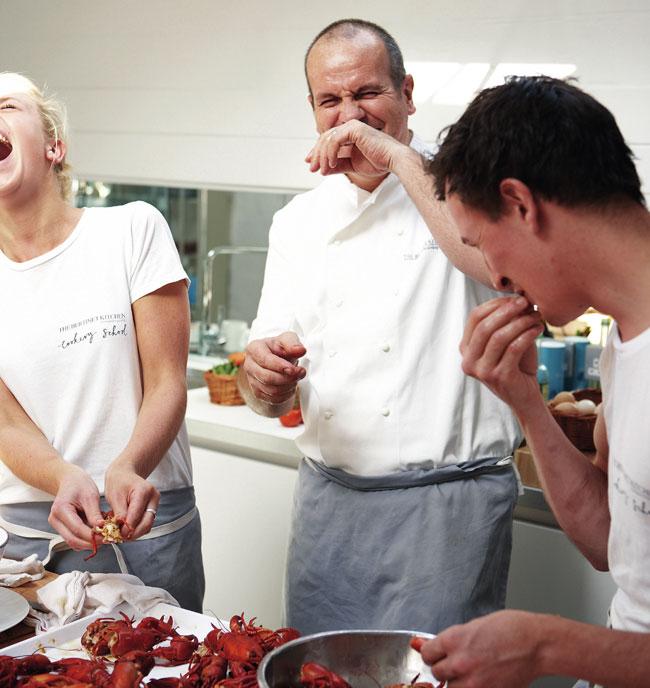

Eleanor Fullalove went to meet French chef and baker Richard Bertinet to find out what influence France has had on his career, and why a dressed crab is a lazy crab….
Having experienced both France and England’s attitude to food and cookery, Richard Bertinet is in a good position to explain the differences between them. Taking the traditional French apéritif as a starting point, he says: “L’apéritif is something we do when you visit somebody. In England you get a cup of tea, in France you get a Pastis or a beer.
“If I go and see some friends that I haven’t seen for years, the lunch apéritif becomes the evening apéritif, it is non-stop grazing. It reminds me of when I was a kid, people coming round for an evening – you don’t go for dinner, you go for an apéritif at somebody’s house. It’s food to go with wine in France, a bit like tapas.”
If Richard had to put his finger on what aspect he misses the most though, he imagines it would be “the sea around Brittany and the fresh air from the Atlantic” – the area around where he grew up – though he admits “When I go on holiday to France, I’m pleased to come back to England as well.”
He plays a very hands-on role at the cookery school in Bath that bears his name and the following recipes are from his third book “Cook“, which sees him move away from bread and put his stamp on dishes as diverse as lamb casserole and vegetable curry. “There’s a lamb casserole in there that could be the same as a lamb navarin but put in a French word and people might think it’s too complicated.”
What about the vegetable curry – surely that can’t be a variation on a French dish? “I discovered the Cape Malay curry when I was in South Africa in 1988,” he explains. “It’s very sweet with lots of different spices. I’ve loved that curry from day one.”
Having experimented with cuisine from around the world, it would be interesting to see how Richard defines the French style. “Great wine takes time to make, great bread takes time to make, great food takes time to make” he says, concluding that “The French have mastered things that take time”.
Perhaps unsurprisingly, the chef also picks up on France’s keen attitude to using local produce. “There is a lot of cooking with what you’ve got growing around where you are, food from the terroir as we call it. Every region has a different flavour.”
Although Richard comes from Brittany, many of his recipes are influenced by Provence. “My parents-in-law bought a house down there seven or eight years ago. That’s when I discovered Provence and I fell in love with it. It’s such a nice, sunny part of the world. All the markets are lively and there are lots of fresh fruits and vegetables.”
But it’s clear that Brittany still holds the chef under its spell and when the subject of seafood comes up, it conjures up various childhood memories. “I was born with a crab in my hand,” Richard declares, adding “A dressed crab is a lazy crab. You want to find the meat yourself, build a little mountain on the side of your plate. It takes time – you’ll eat less but appreciate it more.”
He is keen that everyone gives shellfish a go: “Don’t be scared to eat it with your fingers. It’s something that you learn. When I was a kid, we used to have winkles on Sunday for an apéritif, a big bowl of them with salted butter, some rye bread and a bit of salt. Lovely – you don’t know what you’re missing!”
Thoughts then turn to dessert and how one might choose between the myriad patisseries that France offers. “When strawberries are in season and you see strawberry tarts in the shops, it’s beautiful. In winter, you want apple tart. It’s all about what’s in season.”
His favourite season, it transpires, is spring, “especially in England, everything comes alive. There are a few weeks when the countryside is a really lush green colour. It inspired a salad in my book where we tried to get in every green ingredient.”
And so it seems that whilst Richard has a fondness for food that takes him back to his childhood – an apéritif shared with the neighbours and a great big bowl of seafood on a Sunday – the most crucial thing he brought from France was a fondness for using locally sourced, seasonal ingredients, a principle that he adheres to wherever he is.
Tapenade
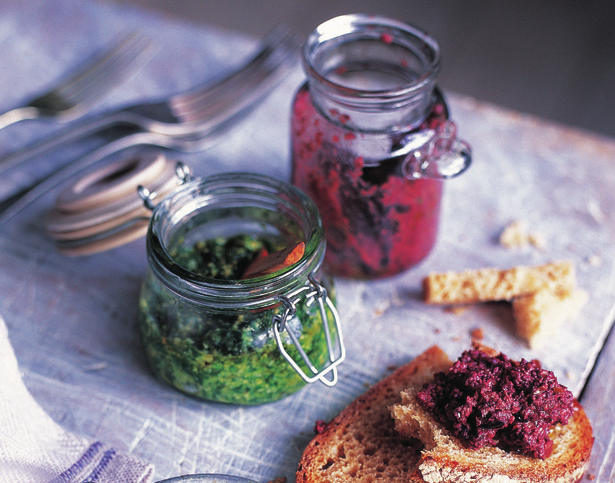
I like to use Kalamata olives for this, but you can use any good-quality black olives. The tuna and anchovies give a really deep ‘meaty’ flavour, but if you want to do a vegetarian version you can leave them out and just add some more olives and capers instead.
Makes enough to fill 2 medium (250ml) jars
Ingredients
Kilner jars
300g black olives
75g tinned anchovy fi llets, in oil
75g tinned tuna, in oil
150g capers, in vinegar
1⁄2 lemon
5 tablespoons extra virgin olive oil
Preparation
✱ Drain the olives, anchovies, tuna and capers. If you are using Kalamata olives they will usually be in oil – if this is good-quality oil, use a few tablespoons in the tapenade in place of the olive oil.
✱ Stone the olives: with a small, sharp knife make three incisions in each olive from end to end – keep the cuts at equal distances – then pull away the three similar-sized segments from the stone, without tearing or bruising the fruit.
✱ Juice the lemon.
Method
Put the olives in a food processor and make good use of your pulse button to chop them quite roughly. Add the rest of the ingredients and keep pulsing in short bursts until you get a coarse paste. I like tapenade to be quite coarse, but some people prefer it smoother, in which case just process it a little more. It really is up to you. You shouldn’t need to add any salt because the anchovies should make it salty enough.
Prawns flamed with tomato and brandy
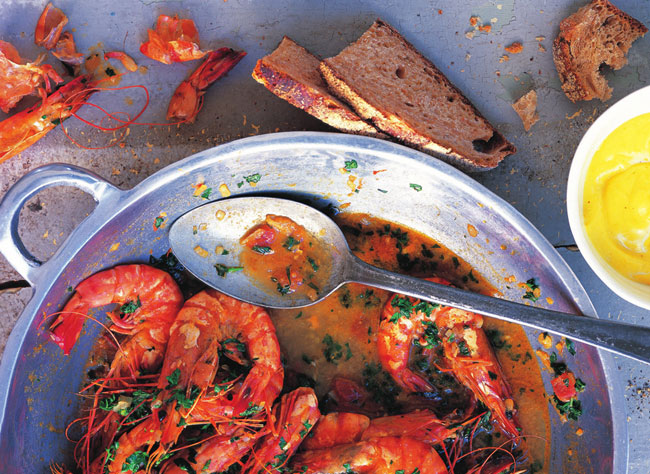
When we go to Provence on holiday this is one of my favourite dishes to make. We visit the market and buy the big Mediterranean prawns that the Spanish call gambas, the ones that look almost see-through when they are raw, but have greeny, blue or brown markings on them. I cook them in their shells in a big frying pan with tomatoes and Cognac, and then we just put the pan in the middle of the table with a bowl of garlic mayonnaise and a basket of bread for mopping up the garlicky juices and everyone tucks in.
For 4 as a starter, or 2 as a main course
Ingredients
1 large banana shallot
2 garlic cloves
2 large tomatoes
1 lemon
about 2 tablespoons light olive oil
16–20 big raw prawns, shells still on
2 tablespoons tomato ketchup
about 100ml brandy or Cognac
large sprig of tarragon
125ml white wine
handful of curly parsley
sea salt and freshly ground
black pepper
Preparation
✱ Finely chop the shallot.
✱ Leave the skin on the garlic cloves, but crush them with the flat edge of a large knife. This releases the flavour of the garlic, but allows you to avoid actually eating it, if you don’t want to, because the cloves are easy to take out.
✱ Peel, deseed and dice the tomatoes.
✱ Squeeze the juice from the lemon.
Method
✱ Heat the oil in a big sauté pan with handles, or a deep frying pan, over a medium heat.
✱ When the oil is really hot but not smoking, add the prawns, shallot, garlic and ketchup. Stir them around well, and then add the tomatoes.
✱ Now we come to the flaming. If you don’t want the brandy or Cognac to flame, just take your pan off the heat and then pour in the alcohol and stir it in. Once it is absorbed into the sauce you can put the pan back on the heat.
✱ If you do want to flame it, and if you are using a gas hob, keep the pan on the heat and pour the brandy into one part of the pan near the edge and tilt the pan towards the flame. It will flame and then die down quickly. If you are nervous, you can add the brandy a tablespoon at a time and the flames will be much smaller.
✱ Once the alcohol is flamed, add the tarragon, lemon juice and wine. Turn up the heat and let it bubble up, to burn off some of the alcohol in the wine, and then turn the heat down to low and let everything simmer for 5–6 minutes, depending on the size of your prawns. If you want to test whether they are ready, take one out and pull off the head. If the colour inside the head is orange, it is ready; if it is black/green and slimy, it needs a little longer.
✱ While the prawns are cooking, quickly chop your parsley and stir it in. If you like you can finish with a twist of black pepper.
Chicken with fennel and herbs
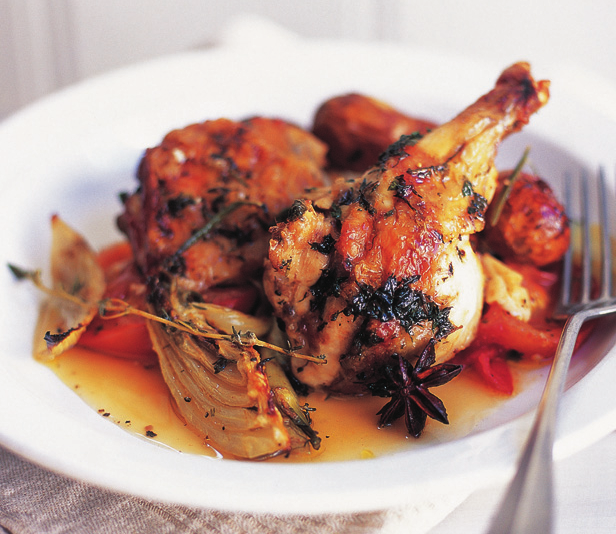
This is all about baking a whole meal in one dish, which you can bring from the oven to the table. I love the aniseedy flavour of fennel.
For 4-6
Ingredients
125g butter
1 corn-fed chicken
2 large fennel bulbs
4 large tomatoes
4 garlic cloves
16-20 small new potatoes
few sprigs of chervil, parsley, rosemary
and thyme
sea salt and freshly groud black pepper
1 large or 2 small unwaxed lemons
2 whole star anise
125 dry white wine
6 tablespoons olive oil
Preparation
✱ Preheat the oven to 200°C.
✱ Take the butter out of the fridge to let it soften.
✱ If you have bought a whole chicken, joint it into 10 pieces so you end up with 4 breast pieces (on the bone), 2 drumsticks, 2 thighs and 2 wings.
✱ Cut the fennel bulbs in half lengthways to give 2 identical halves (as if you had opened out the fennel like a book) and cut each piece lengthways into 4.
✱ Halve the tomatoes.
✱ Crush the garlic cloves with the back of a knife.
✱ Wash the potatoes.
✱ Finely chop the chervil and parsley; leave the rosemary and thyme sprigs whole.
Method
✱ Layer the tomatoes, cut-side up, in a very big roasting dish. Lay the fennel on top, followed by the garlic cloves and a few sprigs of rosemary and thyme. Put into the oven for about 20–30 minutes to start them cooking.
✱ If the butter isn’t soft enough, bash it with a rolling pin! Mix all of the chopped herbs into it.
✱ Put the chicken pieces into a bowl and season with salt and pepper. Add the herb butter and really massage it well into the chicken.
✱ Take the roasting dish out of the oven and put the chicken pieces on top of the vegetables. Cut the lemon(s) in half and squeeze the juice over. Tuck the squeezed halves in amongst the chicken.
✱ If using whole star anise, crush them in a pestle and mortar (or use the end of a rolling pin to crush them on a chopping board). Sprinkle the star anise over the chicken and put the potatoes on top, so that they can brown.
✱ Pour over the wine and olive oil and put in the oven for 30–45 minutes. Halfway through take the dish out and turn the chicken over. The potatoes will tumble underneath, but that is fine. At the end of the cooking time, check that the largest piece of chicken breast and the biggest thigh are cooked by inserting a sharp knife into the meat. The juices should run clear.
Strawberry croustillant
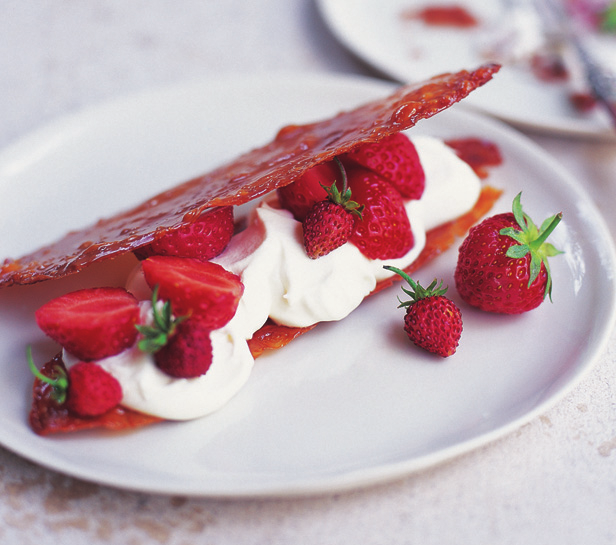
A croustillant is something crispy – in this case, wafer-thin pieces of puff pastry are drenched in sugar and then baked so that they become toffee-ish, before being sandwiched with strawberries and chantilly cream. This is an easy dessert to make, and yet it looks very impressive. You can vary the fruit according to season: any berries – raspberries, blackberries, blueberries – mango or passionfruit, whatever you like.
Makes 6 servings
ingredients
400g small strawberries (or a mix of small and wild strawberries, if you can get hold of them)
200g ready-made butter puff pastry
200g icing sugar
For the chantilly cream
300ml whipping cream
50g caster sugar
few drops of rosewater (optional)
Preparation
✱ Preheat the oven to 200°C.
✱ Line a baking tray with baking parchment or a non-stick mat.
✱ Have a wire rack ready for cooling the croustillants from the oven.
✱ Hull the strawberries and cut them in half.
Method
✱ Form and roll the puff pastry into a sausage shape (see photos below), and then cut it into 12 slices, 1cm thick.
✱ Have your icing sugar in a mound on your work surface and put the first piece of puff pastry, cut-side down, on top of it.
✱ Sprinkle some of the sugar over the top of the pastry and then, using a rolling pin, roll it out until it is very thin and see-through, barely thicker than a cigarette paper. You will need to keep turning the pastry over during the rolling so that it is always coated in sugar and doesn’t stick to the rolling pin. Repeat with the rest of the pieces of pastry.
✱ Lay the croustillants out on the lined baking tray and bake on the middle shelf of the oven for 6–8 minutes until caramelised. Be sure to keep a close eye on them because they burn quickly.
✱ Take the tray from the oven and use a palette knife to lift each croustillant off and onto the wire rack.
✱ To make the chantilly cream, whisk the ingredients together until thick and fluffy.
✱ To serve, place one croustillant on each plate with the side that was facing upwards in the oven, the more bobbly side, downwards. Spoon a little chantilly cream along the length of the pastry and cover with halved strawberries. Top with another croustillant – the more textured, bobbly side that was facing upwards in the oven should be uppermost.
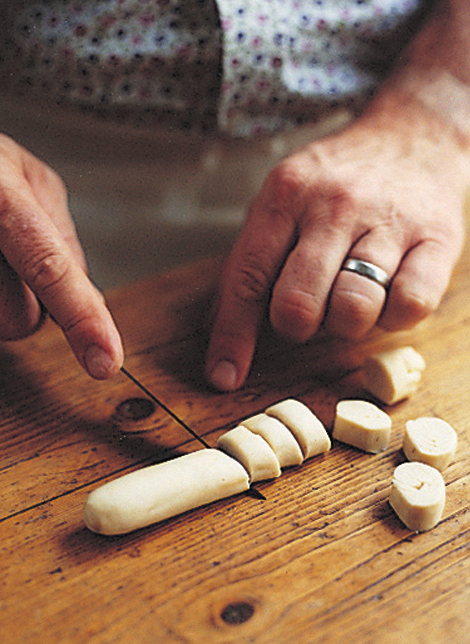
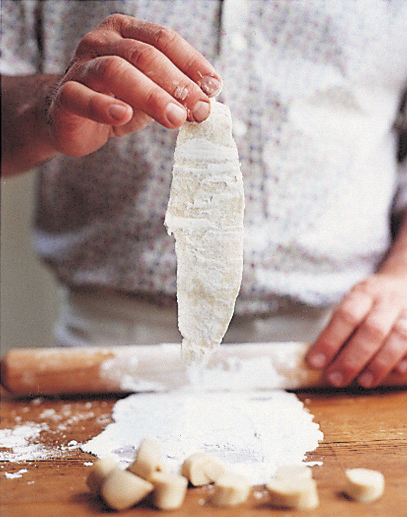
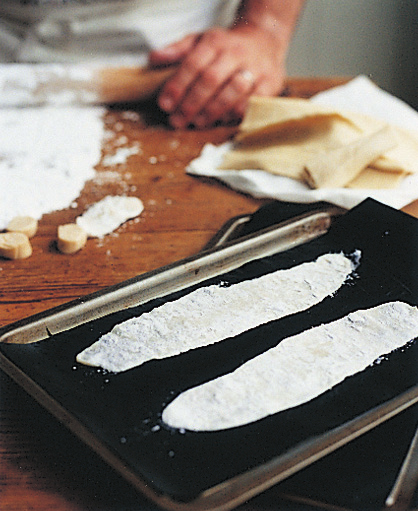
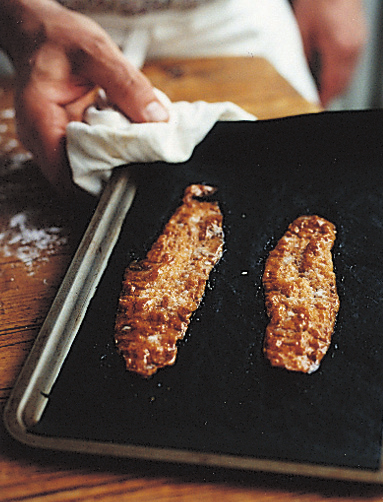
Share to: Facebook Twitter LinkedIn Email
Related Articles
By FrenchEntrée

Leave a reply
Your email address will not be published. Required fields are marked *



